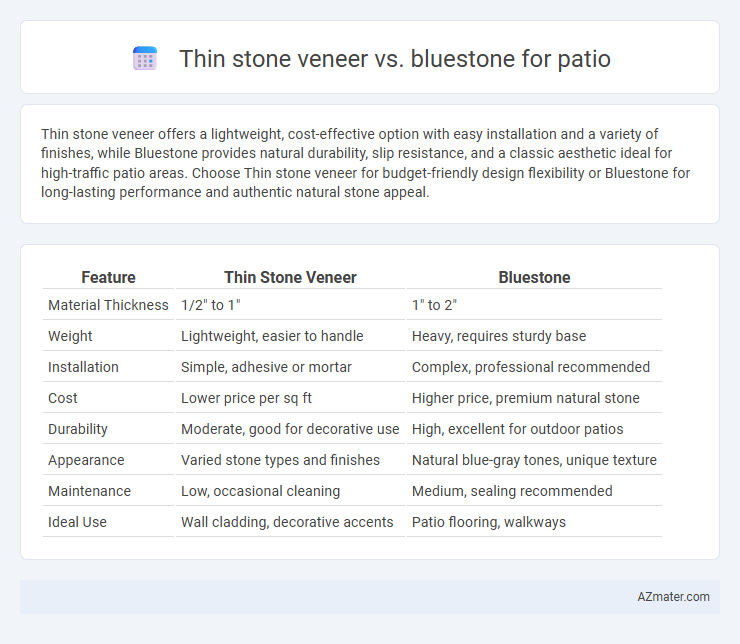Thin stone veneer offers a lightweight, cost-effective option with easy installation and a variety of finishes, while Bluestone provides natural durability, slip resistance, and a classic aesthetic ideal for high-traffic patio areas. Choose Thin stone veneer for budget-friendly design flexibility or Bluestone for long-lasting performance and authentic natural stone appeal.
Table of Comparison
| Feature | Thin Stone Veneer | Bluestone |
|---|---|---|
| Material Thickness | 1/2" to 1" | 1" to 2" |
| Weight | Lightweight, easier to handle | Heavy, requires sturdy base |
| Installation | Simple, adhesive or mortar | Complex, professional recommended |
| Cost | Lower price per sq ft | Higher price, premium natural stone |
| Durability | Moderate, good for decorative use | High, excellent for outdoor patios |
| Appearance | Varied stone types and finishes | Natural blue-gray tones, unique texture |
| Maintenance | Low, occasional cleaning | Medium, sealing recommended |
| Ideal Use | Wall cladding, decorative accents | Patio flooring, walkways |
Introduction to Patio Material Choices
Thin stone veneer offers lightweight durability and versatile installation options ideal for patios requiring natural stone aesthetics without the bulk of full-thickness stone. Bluestone, a dense and weather-resistant sandstone, provides a timeless appearance with excellent slip resistance, making it a popular choice for outdoor surfaces. Both materials deliver unique textures and color variations, allowing homeowners to select based on structural needs, budget, and design preferences for long-lasting patio solutions.
Overview of Thin Stone Veneer
Thin stone veneer offers a lightweight, cost-effective alternative to full-thickness Bluestone for patio surfaces, providing the natural aesthetic of real stone with easier installation. Made from natural stone slabs sliced to a thickness of typically 1 to 2 inches, thin stone veneer maintains durability and weather resistance ideal for outdoor patios. Its versatility allows for application on various substrates, enabling homeowners to achieve the classic Bluestone look while reducing material and labor expenses.
Overview of Bluestone
Bluestone is a dense, durable natural stone commonly used for patios due to its strength and elegant blue-gray color, which ranges from light to deep shades. Its slip-resistant surface and weather-resistant properties make it ideal for outdoor applications, providing a long-lasting and low-maintenance option. Compared to thin stone veneer, bluestone offers a thicker, solid slab that delivers enhanced structural integrity and a premium aesthetic for outdoor spaces.
Aesthetic Differences: Thin Stone Veneer vs Bluestone
Thin stone veneer offers a sleek, uniform appearance with a wide variety of colors and textures, allowing for precise customization and modern design aesthetics. Bluestone, known for its natural, earthy tones and slightly rough texture, provides a classic, rustic look ideal for traditional or outdoor landscapes. The aesthetic choice between thin stone veneer and bluestone depends on whether a polished, engineered finish or a natural, time-weathered surface is preferred for the patio.
Durability and Longevity Comparison
Thin stone veneer offers a lightweight alternative to traditional bluestone, providing excellent durability with proper installation and maintenance, but it may be more susceptible to chipping and weathering over time compared to solid bluestone slabs. Bluestone is a dense, natural stone known for its exceptional strength, resistance to heavy foot traffic, and long-lasting weather resilience, often lasting decades with minimal degradation. For patios exposed to harsh climates or heavy usage, bluestone typically outperforms thin stone veneer in terms of longevity and structural integrity.
Installation Process and Complexity
Thin stone veneer offers a straightforward installation process, ideal for DIY projects due to its lighter weight and ability to adhere directly to existing surfaces with mortar or adhesive. Bluestone, a natural full-thickness stone, typically requires more complex installation involving a stable base, precise leveling, and professional cutting to fit the patio layout. The complexity of bluestone installation often results in higher labor costs and longer project timelines compared to the relatively quick and simple application of thin stone veneer.
Cost Analysis: Thin Stone Veneer vs Bluestone
Thin stone veneer offers a cost-effective solution for patios, with prices generally ranging from $6 to $12 per square foot, making it significantly more affordable than bluestone, which can cost between $15 to $30 per square foot due to its natural durability and thickness. Installation expenses for thin stone veneer are typically lower as the material is lighter and easier to handle, reducing labor costs compared to the heavy, dense bluestone slabs that require more preparation and specialized equipment. When balancing budget considerations with longevity, thin stone veneer serves as a stylish, economical alternative, while bluestone commands a premium price for its natural stone quality and long-term resilience.
Maintenance Requirements
Thin stone veneer for patios demands minimal maintenance due to its lightweight nature and resistance to cracking, requiring only periodic cleaning with mild soap and water to prevent dirt buildup. Bluestone patios, while highly durable, necessitate regular sealing every 1-2 years to protect against staining and weathering, and occasional power washing to maintain its natural appearance. Both materials benefit from prompt removal of debris and organic matter to prevent surface damage and prolong their lifespan.
Climate Suitability and Performance
Thin stone veneer offers excellent climate adaptability, providing durability and resistance to freeze-thaw cycles in colder regions while maintaining heat resistance in warmer climates. Bluestone, a dense and naturally slip-resistant sandstone, performs exceptionally well in humid and wet climates, resisting water absorption and preventing surface damage. Both materials ensure long-lasting patios, but thin stone veneer excels in customization and weight considerations, whereas bluestone stands out for its natural weathering and textured finish.
Choosing the Best Material for Your Patio
Thin stone veneer offers a lightweight, cost-effective option with easy installation, making it ideal for DIY patio projects and surfaces that cannot support heavy loads. Bluestone, a dense, durable natural stone, provides superior weather resistance and a timeless aesthetic, perfect for high-traffic outdoor patios exposed to varied climates. Selecting between thin stone veneer and bluestone depends on factors like budget, structural support, desired appearance, and long-term durability requirements for your patio.

Infographic: Thin stone veneer vs Bluestone for Patio
 azmater.com
azmater.com